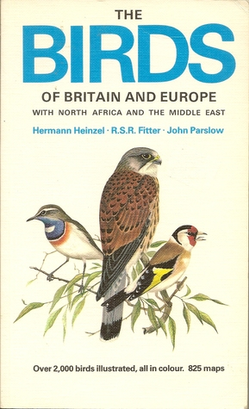
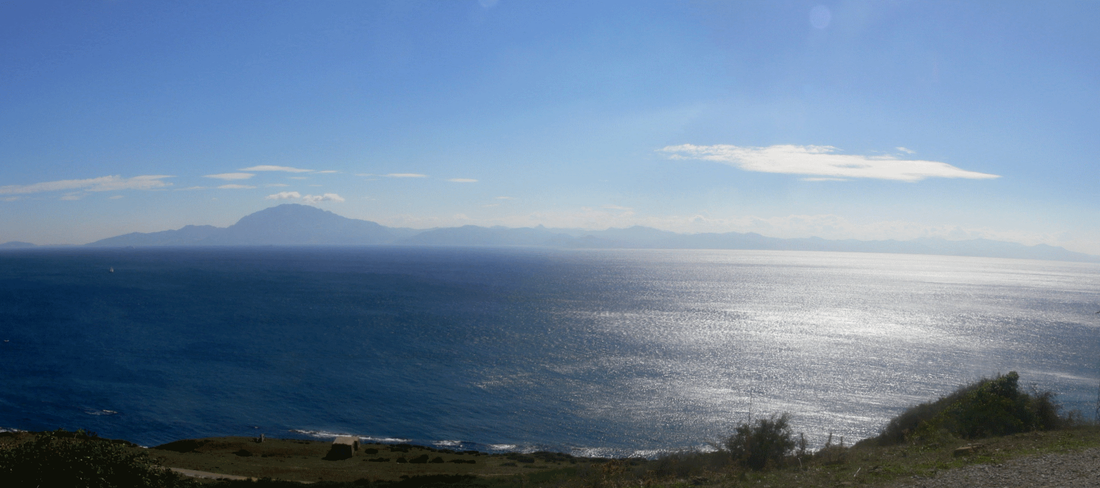 Morocco - the long Promised Birding Land
Morocco - the long Promised Birding Land 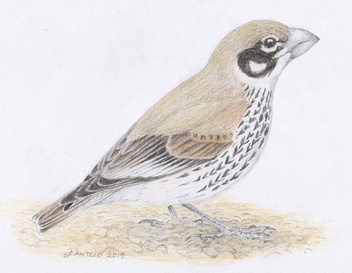 Thick-billed Lark
Thick-billed Lark 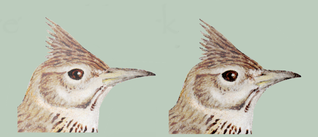 Maghreb vs Crested Lark
Maghreb vs Crested Lark 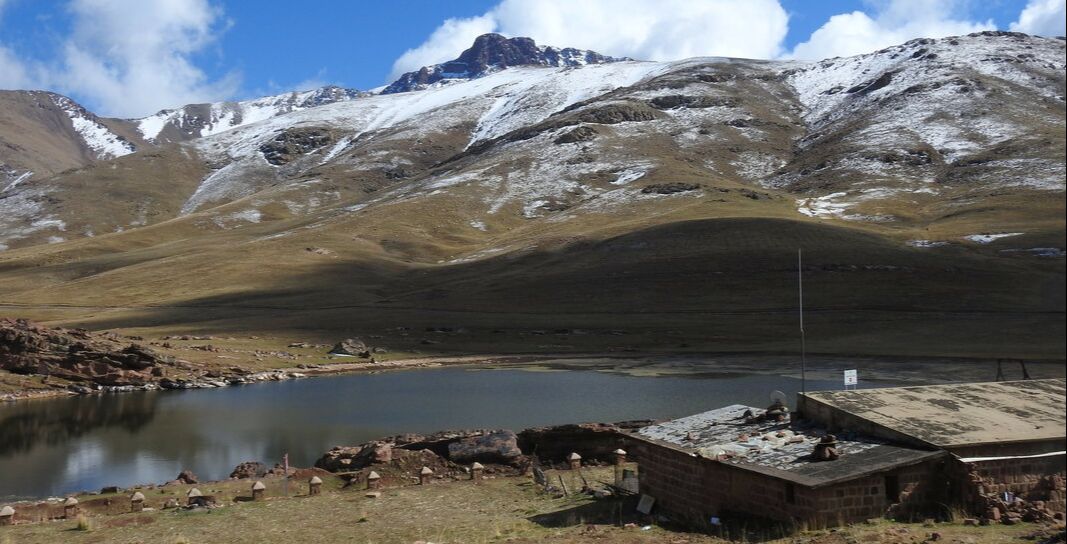
| Birding Cadiz Province |
|
 For birdwatchers much under 50 it must be hard to appreciate just what an impact "The Birds of Britain and Europe" by Heinzel, Fitter and Parslow made when it was published way back in 1972. It was only two years previously that Roger Tory Peterson's fieldguide finally had its first serious rival, "The Hamlyn Guide to Birds of Briatin and Europe" by Bruun and Singer. The latter guide introduced us all to the now standard 'plate-opposite-text-layout' format but was seriously flawed by often lamentable illustrations. Not only were Heinzel's illustrations far better (although not quite up to Peterson's standards) but even before we saw the illustrations and text, the book's subtitle "... with North Africa and the Middle East" alerted us to the fact that here was something radically different: in effect a guide to the Western Palearctic (not that most of us knew at the time exactly what that meant!)! For all but a handful it introduced us to the exotic birds (rare vagrants aside) to be found on Europe's doorstep.  Morocco - the long Promised Birding Land Morocco - the long Promised Birding Land Whilst a good proportion of the eastern species were not entirely unfamiliar (many being vagrants to the west) for many, me included, it was the illustrations of North African species that really enthralled particularly many of the passerines; the familiar looking yet strange wheatears, exotic larks, curious warblers and much else. The stand-out bird for me, as it was again for many, was Hoopoe Lark. If a camel is "a horse designed by a committee" then the same committee, armed with a little more experience, probably designed the Hoopoe Lark (Alaemon alaudipes) taking the long legs and stance of a courser, the bill of a thrasher and the wings of a hoopoe to concoct a bird quite magnificent in its oddness. For over forty years for me it remained a must see, rather the have seen, bird. Such birds may have helped form the initial desire of visiting North Africa but it was gazing across the straits from Spain at Jebel Musa that transformed it into a determination to do so as soon as I was able. Due to that infamous spoiler of the best laid plans, fate, I found myself unable to visit North Africa for almost a decade longer than I'd hoped. Since most of my birding pals had already visited the area (some several times) the best option, given my increasingly poor hearing, was to join a commercial birding trip with people with working ears. Fortunately, Naturetrek had vacancies on a trip they were running so on 7th March I joined a group of fellow hopefuls on an early flight to Marrakesh. One of my targets, apart from the mythical Hoopoe Lark itself, was to bump my lark list from a mediocre eight (Sky, Wood, Shore, Greater & Lesser Short-toed, Crested, Thekla's and Calandra Larks) to a more respectable dozen or so. I also wanted to grapple with the problem of distinguishing Crested/Thekla's in a North African context. As we climbed up into the Atlas Mountains through steady drizzle we saw the odd wayside Crested Lark but it was only when we breached the misty ceiling to emerge into the sunlit uplands that we got our first decent views of any larks. Those larks were as familiar as their surroundings seemed alien. What we call 'Shore Larks', a name based on where we happen to see them winter, the rest of the world know as Horned Larks. Despite being aware that they were breeding birds of the high peaks, it remained disconcerting to see them happily feeding on alpine meadows or scree slopes rather than the seashore. Closely related to our visitors from Scandinavia (Eremophila alpestris flava), these birds belong to the local North African race (E. a. atlas). The plumage differences are subtle to the point of being invisible unless you look for them (the mask bolder, the horns longer and, to my eye, a warmer rusty hindneck) but,unlike the ones we know as winter visitors, these birds only move further down the mountain in winter rather than decamp to the seaside. Several flocks of up to 20-30 birds happily flitted around although none lingered close-by long enough for my inadequate photographic skills to grab a photo. Heading south towards the rim of the Sahara more Crested (Galerida cristata) and doubtless many Thekla's (Galerida theklae) Larks darted away as we passed without giving a chance of close scrutiny. Fortunately, on reaching the dry stony plains, I discovered that Temminck's (Horned) Larks (Eremophila bilopha), had no such reservations. In pattern the plumage was clearly similar but the general colouration had a warm, sandy isabelline tone which served to highlight the bold black horns, bandit mask and chest crecent. Given the close similarity in plumage pattern between this and Horned Lark , it's not surprising that this attractive species was once classed as a supspecies of Horned Lark but in the field they had a different jizz as, despite a relatively small difference in length (14.5-16 cm vs 16 - 18 cm), they seemed surprisingly diminutive, compact and less robust than their cousins. Young birds were a surprise - their plain warm sandy plumage was unexpected (reflecting my failure to do any homework!) which caused me to momentarily consider whether they were Desert Lark!  Thick-billed Lark Thick-billed Lark Rivalling Hoopoe Lark on my 'wants' list and in many ways its polar opposite was Thick-billed Lark (Ramphocoris clotbey). This is a chunky lark with, as its name suggests, a heavy Hawfinch-like bill is a very distinctive species. Although I later had several fly-by birds (which are equally distinctive in flight thanks to the bold white trailing edge to the wing which contrast nicely with the rest of the flight feathers which are blackish ), I only once managed to see them well on the ground. The small flock was actively feeding in low open scrubby cover. Like most desert larks they were predominantly sandy coloured above and paler below but unlike the next species the head and chest were boldly marked with dark blotches and chest streaking. Since neither I nor, it seems, anyone else got a decent photo of the bird I offer my sketch (above) as a poor substitute. Incidentally, its scientific name derives from the somewhat unfortunate (to Anglophone ears at least) surname of French medic Antione Clot who was given the Egyptian honorific 'bey' for his services to medicine having, remarkably, founded a School of Medicine for women in Egypt in 1832.  Maghreb vs Crested Lark Maghreb vs Crested Lark Desert Larks (Ammomanes deserti) proved even more bland and characterless as the young Temminck's but not nearly as approachable. In the field guide they sport paler underside and modest streaking on the chest but in the field the harsh light from above bleached out the tawny-grey upperparts and cast a strong shadow below making them seem almost uniform in colour. For the most part we had them, as the books suggest, on rocky often sloping ground. I'd like to say more about Bar-tailed Desert Lark (Ammomanes inctura) but I only saw one fleetingly albeit fairly well. They too looked somewhat bland but to me they seemed more strongly patterned on the head than their close relative with a bolder supercilium and whiter 'collar' combining with the subtly darker cheeks. The clincher was the tail bar and the darker wingtips although that it was in an area with sandy dunes also helped! One to go back for. The same can hardly be said of Maghreb Lark (Galerida (c) macroryhcha) which we saw in the same area as the Bar-tailed Lark. This species - or subspecies - was, as far as I could discern, identical in plumage to the Crested Larks we'd been seeing elsewhere in Morocco (and those I've seen in southern Spain). They're supposed to be paler and sandier than the general run of Crested Larks but the combined effects of wear, strong desert light and the reflected colour from the surrounding makes such a distinction a rather fine one in the field. It may be auto-suggestion but the bill looked longer than I've seen on 'typical' Crested Larks. My reference books tell me that, as befits its scientific name (macroryhcha means 'long-billed), Maghreb Lark has a bill length of 19.5-25.5 mm vs 17.6 - 21.3 mm in cristata (see my diagramatic sketch). Obviously, there's a degree of overlap but birds with bills at the longer end of the range should look different. Fortunately, the most obvious characteristic, the location where we saw it in Morocco, is said to be the most diagnostic feature of all! My intention to get to grips with the local Crested Larks was thwarted largely by my indifference to them when more exciting larks (and species like Mousier's Redstart) were on offer. I did find myself momentarily confused by a couple of Crested that seemed to have the short stubby bills that I associate with Spanish Thekla's. However, on closer inspection they proved to be young Crested Larks; I'd forgotten how early they'd be breeding this far south. On the last day, however, I did manage to obtain good views of the local Thekla's Lark when the rest of the party were enjoying Bald Ibis (although technically an untainted lifer I've seen too many of them in Spain to get too excited). As expected, the birds proved to be quite distinct from the Spanish birds I see (far more so than Maghreb Lark) which are usually greyish-brown birds with dark blobby chest markings and a relatively stubby bill. In contrast these birds were distinctly warmer brown in tone and had a bill the length similar to many Crested Larks (although biometrics don't seem so very different) However, although not easy to see the lower mandible was convex (best seen when the bird was facing away from or towards me thanks to the foreshortening effect of x8 magnification) and in flight there was a distinct contrast between the brighter rustier upper-tail coverts and the rest of the upperparts. The underwing also seemed greyish (although I didn't get a good view of this feature). Once home and able to examine the photos closely, I was concerned to note that the last primary feather was shorter than the primary coverts - a feature I associate with Crested Lark. Fortunately, when I posted my photos on Bird Forum Bird ID guru Grahame Walbridge (who I knew decades back from my days visiting Portland Bill) confirmed that, contra to what I'd been told, Thekla's can have relatively short primary like this. Phew! On range these birds should be Galerida theklae ruficolor. But what of my main target, Hoopoe Lark? On our first day in the desert just after we caught up with Temminck's Lark we pulled off onto a dirt track heading off towards nowhere in particular. There we found still more Temminck's plus our first small parties of highly mobile migrating (Greater) Short-toed Lark (Calandrella brachydactyla) which were to be a regular feature of our time in the desert. Scanning the stony desert immediately after we emerged from the van, I was the first to clap my unbelieving eyes on this mini-Road Runner of a bird. I quickly got everyone on to it in pretty short order but I doubt if anyone was quite excited as I was! The bird didn't just live up to my high expectations, it exceeded them. The following day we saw more on a 4x4 drive across the desert where we also saw Maghreb and Bar-tailed Desert Larks with a supporting cast of African Desert Warbler, Desert Sparrow, Cream-coloured Courser, Egyptian Nightjar and Houbara (none of which, not even the bustard, came close to matching the charisma of the Hoopoe Lark). It was enough to see them sprinting across the desert between hesitating for a moment or two but there was more to come. Perched atop a convenient bush they voiced a series of piercing chimes (see https://www.xeno-canto.org/species/Alaemon-alaudipes) before launching a twisting leap into the air so they could semaphore their amorous intentions with the black-and-white flags of their wings. I was so enraptured by finally seeing one that I nearly forgot to take any photos but happily just before we left them the bird below posed beautifully for me. Did I really open by saying this vision of gorgeousness could have been designed by a committee? Well, perhaps so if they were organised by Heineken since it's the best lark in the world .... probably!  My Promised Birding Land across the straits proved to be even more diverse and fascinating than I'd imagined. On the high peaks of the Atlas Mountains (above) I experienced mist, rain, snow and bright sunshine. The Moroccan desert was uniformly bright and sunny but took many forms from rugged rocky slopes, stony plains with a sparse cover of grasses dotted with isolated trees to flat sandy deserts (below). Each habitat had its own community of birds, in some like the palm fringed oases they were surprisingly familar (e.g. Blackbird, Greenfinch, Goldfinch & Linnet) but those out on the desert proved to be even more exotic and mysterious than I'd hoped when I first opened Heinzel, Fitter and Parslow's guide all those decades ago.
2 Comments
|
About me ...Hi I'm John Cantelo. I've been birding seriously since the 1960s when I met up with some like minded folks (all of us are still birding!) at Taunton's School in Southampton. I have lived in Kent , where I taught History and Sociology, since the late 1970s. In that time I've served on the committees of both my local RSPB group and the county ornithological society (KOS). I have also worked as a part-time field teacher for the RSPB at Dungeness. Having retired I now spend as much time as possible in Alcala de los Gazules in SW Spain. When I'm not birding I edit books for the Crossbill Guides series. CategoriesArchives
May 2023
|